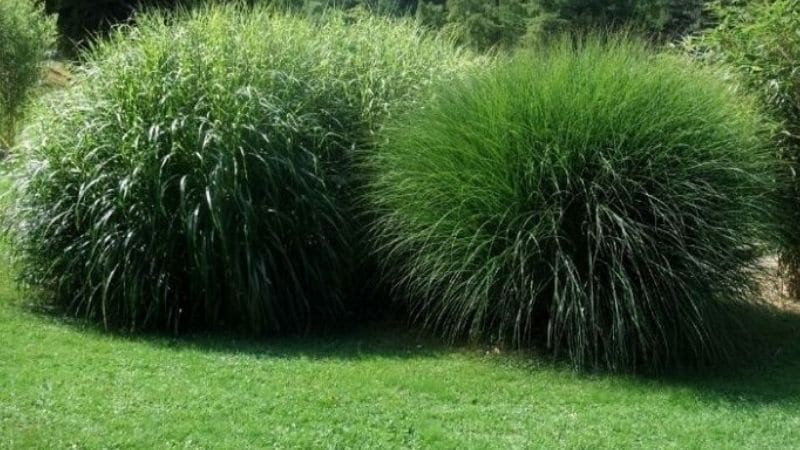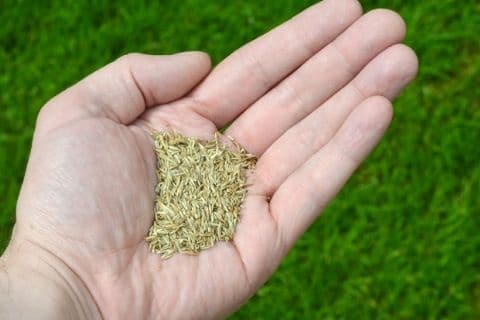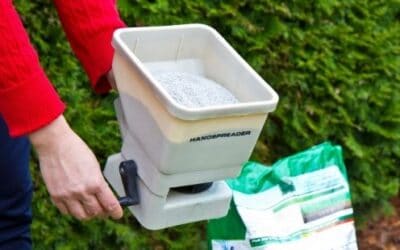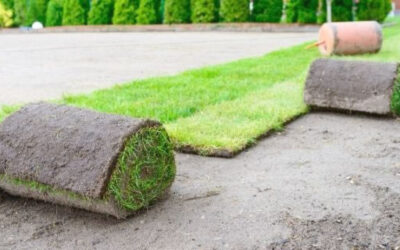Best Time to Plant Grass Seed | Step By Step Guide

If you want to achieve a healthy, lush lawn, it is essential to properly plant your grass seed. Proper timing will allow your grass seed to germinate well and get established well before unfavorable weather conditions and stresses come. If your planting season aligns with your seed’s active growth period, you will be guaranteed a fast-growing and healthy grass.
You probably want a fantastic lawn that you can enjoy for all year round. It is easy to achieve and it won’t cost you much. You just have to be armed with adequate and proper information for great outcome. In this article, I share with you some pieces of advice on the best time to plant grass, so read on.
Planting grass seed – what you need to know
Know the type of seed you want to plant
When planting grass seed, you need to know your grass seed variety and its active growth period. Some grass seed varieties grow well in cool conditions while others grow well in warmer conditions. Planting the right grass at the right time is important if you want your seed to germinate well and grow into a healthy, lush lawn.

Types of grass seed
Know Your Area for the Best Time to Grow Grass Seed
You also ought to know the weather patterns that prevail in your area. Lawn varieties that grow well in America may not grow well in Australia. If you know your type of grass and understand your soil type and weather patterns that prevail in your area, and you will be good to start planting your grass.
Examples of grass seed varieties
Below I have listed the different varieties of grasses and the best season to plant them.
Late summer and early fall
Cool-season grasses grow fast and healthy during the cool temperatures of late summer and early fall. Below is the list of some of these grasses.
- Kentucky bluegrass
- Perennial
- Ryegrass
- Tall fescue
Late spring and early summer
Warm-season grasses grow well during the warmer temperatures of late spring and early summer. Below is a list of some of these grasses.
- Bermudagrass
- Bahiagrass
- Zoysia grass
- Centipede grass
Characteristics of common grass species
Grasses come in different varieties, each possessing its own unique set of characteristics. These characteristics are the ones that make each grass variety to adapt to certain conditions. When you want to plant grass seed, it is important to know the grass variety you want to plant and the conditions it favors. You wouldn’t want to plant a grass variety that will not adapt to your area’s environmental conditions.
Kentucky Bluegrass
Kentucky Bluegrass is popularly grown in New Jersey. It has a beautiful color and leaf texture. What makes it outstanding is that it is hardy, well-adapted, and tolerates shade. Kentucky Bluegrass is resistant to disease and grows vigorously in well-drained soil. Its shortcoming is that it is slow to establish. If you know your soil is well-drained, then bluegrass is a great choice for your lawn.
Perennial Ryegrass
Perennial Ryegrass is popularly known for its beautiful color. Its leaves are finely textured, and its adaptability to a wide variety of soil conditions makes it outstanding. In wet areas, perennial ryegrass grows poorly. Once planted, it establishes pretty fast. If you’re not that sure about your soil’s type, perennial ryegrass can be your perfect choice of grass. Its capability to adapt to a wide variety of soil conditions makes it one of the outstanding grasses.
Fine Fescues
Fine fescues are shade tolerant and can do pretty well in dry and less fertile environments. However, it is intolerant to high traffic. With fine fescues, you do not have to worry about your soil being infertile or dry. You also don’t need to spend your money on fertilizers as your grass can grow well in that infertile soil. Amazing, right?
Tall Fescues
Tall Fescues does well in soils that are moderate to well-drained. It is popular for its ability to grow well even in infertile soils. It tolerates both drought and high traffic. For you to make it even outstanding, tall fescues establish from seed rapidly. As with fine fescues, if your soil is one of those infertile soils, you should not worry. Just make sure this wonderful grass variety is your choice, and you will be amazed by how well your grass will grow. Choosing tall fescues also benefits your pocket as you won’t have to buy expensive fertilizers to enrich your soil.
Why fall is a suitable time to plant cool-season grass
For best grass seed germination and vigorous growth, consider growing cool-season grasses in early autumn or spring. This, with other lawn care measures you may implement to help your lawn grow well and this will give you great results.
Planting cool-season grasses in early autumn
Early autumn is considered the best time to plant cool-season grasses. In early autumn, the soil is still warm; day temperatures moderate coupled with cool evenings, encouraging rapid growth and establishment of grass seed. Your grass will germinate well if you grow it at least six weeks before the estimated day of the first frost in fall. The goal when planting cool-season grass is to make sure temperatures are not unfavorably cold. You can use a garden thermometer to find out the temperature of your soil. If it is 50°F and 65°F, then it is ideal for your cool-season grasses.
The other reason why fall is the best time to plant grass is that the fall season offers more precipitation, suitable for your grass. You probably don’t want your grass seed to dry out. Rain will help the soil to be moist, thereby creating favorable conditions for your grass to thrive. Furthermore, more rainfall means you will have to water your grass less. So fall lawn care is an easy task.
Note: Grass seed requires warm and damp soil to germinate well.
Planting cool-season grasses in spring
Spring is another great time to sow your cool-season lawn seeds. This is so because it is the time of the year when both soil and air temperatures will be optimal. This helps your newly sown grass seed to germinate well and establish well. However, early spring rains and melting snows can cause early weeds to kick in, disturbing the newly down grass. In this light, you ought to seek advice from your county agent on when unfavorable weather conditions will come to avoid planting your seed during that time. You should not just plant your cool-season grasses at any time as your efforts can go in vain.
Spring is the best time to plant warm-season grasses
Warm-season grasses are best planted in spring. When planting your grasses in spring, you don’t have to do it at the first hint of spring. It is important to wait until frost falling has ceased, and the soil is now warm. Warm-season grasses germinate pretty well in the 65°F to 70°F temperature range. You can grab your garden thermometer and take your soil temperature to eliminate guesswork. You also need to be as accurate as possible to ensure rapid and vigorous grass seed germination and achieve a lush lawn.

Warm-Season Lawn
Your warm-season grasses will rot or germinate poorly if you plant them in cold, wet soil. It is important, therefore, to avoid growing them during times when frost falls. If you are not sure when unfavorable weather conditions will factor in, you can seek your county extension agent’s advice. You do not want your labor to go in vain.
For your grass seed to germinate well and establish well, plant them at least 12 weeks before falling the first frost. The goal is to plant warm-season grass seed well before winter when there is still the warmer summers have to offer. Furthermore, it is important to plant your grass seed during this time, before the winter dormancy factor. Your grass seed will perform better and put a smile on your face if you plant it at the right time.
Summer and Winter aren’t good times to plant grass seed
Winters and summer come with extreme conditions that hinder the growth of your newly sown grass seed. We know winter lawn care is a bit difficult anyway. That time lawn grass can’t grow its own forth. It may be possible to plant your lawn seed in summer and winter; however, your grass will never perform at its best. There is an exception for those who live in areas where the four seasons (summer, autumn, winter, and spring) are replaced by only wet and dry seasons. In such places, sowing grass seed in times where rainfall inconsistent will pay off and ensure your down seed grows healthy and strong.
In some places where there are four distinct seasons, make sure not to plant your lawn seed in winter as your newly sown or germinated grass will be at risk of going into a state of dormancy because of the cold. You won’t like the patchy lawn that will come due to winter dormancy. Summer heat will do more harm than good to your grass. It stresses out your seed, causing it to brown off. Furthermore, more water will be required to ensure the growth of your grass. If you do not want your grass seed to shrivel up and die, shun seed planting in the hot and dry summer months.
Note: The best time to grow grass depends on the lawn variety you grow as well as where you live.
Importance of proper timing when planting lawn seed
Depending on the type of grass seed, proper timing is advantageous as it allows seedlings to root in pretty well and get established well before unfavorable stresses hit.
Proper timing when planting grass is necessary as your newly planted grass seed will face less competition from weeds. Because your grass will be well rooted and established, it will choke out weeds pretty effectively. And this ensures the healthy growth of your lawn. Furthermore, it saves you the labor of dealing with stubborn weeds in your lawn. It as well saves you money as you won’t have to deal with chemical weed killers who are sometimes expensive.
Important steps to plant grass seed
Timing is not the only thing you should consider when planting grass seed. Other things are important if you are to grow a fantastic lawn. Below are several things you ought to consider when planting your grass.
Proper grading or leveling is important.
To create a fantastic lawn that you will enjoy for a long, you should have a great site preparation plan. Grading is key if you want to avoid water runoff problems, increasing the risk of soil erosion. Grading also ensures you avoid problems like having a waterlogged lawn area. It is important when planting a new lawn to establish a sloping grade. And grading should be done a distance from buildings.
Soil preparation
Before seeding, it is important to take some steps to ensure when you plant your grass; it will grow well. One of the most pivotal steps you ought to take when preparing your soil that is soil testing. The outcome you get from your testing will allow you to know your soil’s nutrient requirements and the liming required.
Liming
For your germinating grass to utilize fertilizer and several nutrients, proper liming is a necessity. You probably want your growing lawn to benefit from the nutrients available in the soil and those you add in through fertilizers. If this is so, then liming is the way to go.
Soil amendments
You may want to consider adding soil amendments to ensure your grass seed grows into a fantastic, lush lawn that you can enjoy for a lifetime. Soil amendments, many times are confused with fertilizers; however, they serve different purposes. Soil amendments affect plant growth indirectly, unlike fertilizers.
Soil amendments like organic matter are great since they help fertilizers to perform better and yield impressive results. It is pivotal to add organic matter to your sandy or clay soils if you want your grass seed to benefit from well-aerated soil with adequate moisture-holding capacity.
Fertilizing
Feeding your soil with nutrients will greatly help your grass to grow healthy and strong. Apply Preplant incorporated fertilizer or starter fertilizer following the results of your soil testing. Apply the starter seed just before sowing in grass seed or together with your seed. Post plant fertilizer can be applied following your pre-plant incorporated fertilizer.
Choose special seeds for the first time.
Products like Miracle-Gro Evergreen Super Seed Lawn Seed and Miracle-Grow Evergreen Fast Grass Lawn Seed are great choices if you plant lawn seed for the first time. They come in handy due to their versatility, coupled with the fact that they are hard-wearing. There are also mixed varieties of grass seed that you can choose from when you want to plant grass seed.
Ensure you care for your newly planted lawn
In the first catch-up, we should ensure proper care for the newly planted lawn. Planting your grass seed at the proper time is rewarding. However, it does not eliminate other measures you may want to take to ensure your lawn’s healthy growth. When the ground is unusually drier, watering your lawn is key if your lawn seed is to germinate and establish well.
In Summary
- The best time to plant grass depends on factors like your grass type and where you live.
- There are cool-season grasses and warm-season grasses. Cool-season grasses favor climates that are more temperate while warm-season does well in hotter tropical or subtropical weather.
- Proper timing when planting your grass ensures rapid germination and well establishment of grass. It also enables your grass to outcompete weeds giving you a beautiful lush lawn.
- In order to maximize the benefits of proper timing to your lawn, you should take appropriate care of your growing grass by fertilizing it, liming, etc.
Final Verdict
The time you plant your grass seed is a great factor in determining how well your seed germinates and establishes and how healthy it will grow. If you have been planting grass seed anytime, you would have thought about it, and it is high time you stop that. The best time to plant grass seed is when the conditions are favorable for germination. Furthermore, you ought to know your grass seed variety and the type of conditions it adapts to. Overall, if you are looking for more solutions for your landscape, feel free to browse through our site. You’ll get a handful of information that will help you to turn your landscape to be attractive all year round.

Kazi Taslim
Editor
Poweredgrip ensures an expert team of writers, to provide you with excellent informational and unbiased content. We are dedicated to giving you much smoother and best up to date information. We share the incomparable tricks, tips that give you awareness and confidence for making your buying decision. We are a very enthusiastic, dedicated and hard worker. Kazi Taslim is the Author and Editor of our experienced writing team.
Related Post
When to Aerate Lawn I Complete Lawn Aeration Guide
Lawn aeration is vital for the reduction of turf's thatch layer and for combating soil compaction. For the aeration to be adequate, you must carry it out at a specific time depending on a set of conditions, including the cultivar or type of lawn, weather...
Organic weed control for lawns | Natural weed controlling Tips
As a gardener, you could spend a lot of time and effort on nurturing your lawn. While helping it reach its optimum potential, on the dawn of your contentment, you notice the presence of weeds, which seem to be thriving. Weeds are not as friendly as they could disturb...
Lawn Care Schedule for All the Year Round
Having a lawn care schedule can be pretty rewarding if your goal is to have a lush lawn. All year-round, you need to take proper care of your lawn, and this involves applying fertilizer, mowing, watering, edging, dethatching, etc. For every lawn care activity, proper...
When to Fertilize Lawn: A Complete Fertilizing Tips
To a certain extent, lawns are somewhat similar to human beings. They require a good diet and proper care for them to perform highly and stay beautiful. For instance, green and lush lawns depend on properly timed, balanced nutrition to look and develop to their best;...
How to Plant a New Lawn: A Complete Beginner Guide
Planting a new lawn is the best way to a subtler look and more excellent value to your yard. It allows you to choose your desired variety of lawn without the hassle. After all, no one wants an imperfect lawn. Well, you don't need to be a landscaping guru to start a...
Best Way of Fertilizing Lawn: Lawn Fertilizing Tips
What's the Best Way of Fertilizing Lawn? Fertilizer provides nutrients that allow the lawn to grow and flourish. It keeps it looking good, maximizes the dark green color and helps it better copy with seasonal turf stresses like heat, drought as well as cold. It...







Trackbacks/Pingbacks